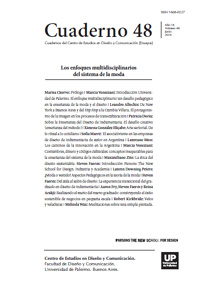Achieving the new graduate dream: building sustainable business success at a small scale
Résumé
Los graduados en diseño de indumentaria se inclinan cada vez más por dirigir
sus ambiciones profesionales hacia los pequeños emprendimientos empresariales en lugar
de dedicarse a las tradicionales opciones de práctica corporativa. Estos empresarios de la
moda deben comprometerse con el desarrollo empresarial y de gestión, habilidades que
normalmente no requiere de diseñadores dentro del modelo de negocio de las empresas.
¿Cómo debería prepararse el empresario de la moda del futuro? ¿Qué conocimientos y
habilidades se requieren para convertirse en un empresario de la moda? ¿Existe una desconexión entre lo que los emprendedores graduados en moda creen que necesitan saber y las
prácticas que en realidad mejor los prepara para iniciar y mantener una empresa de diseño
de moda? Los autores abordan el entrepreneurismo de la moda en Nueva York, discuten la
logística de los mercados masivos globalizados y los desafíos actuales de la pedagogía del
diseño de moda en relación a la preparación para incorporarse en el contexto mundial de
la moda. Luego los autores destacan la tendencia contraria que se da en las empresas locales
de pequeña escala. Finalmente se proponen estrategias generales dirigidas hacia el empresario de la moda que desea crear un negocio sostenible en pequeña escala en Nueva York.
Références
Choi, T-M., Liu, S-C., Tang, CS, & Yu, Y. (2011). A cross-cluster and cross-region analysis of fashion brand extensions. Journal of the Textile Institute, 102 (10), 890-904.
Dean, T.J., Brown, R.L., & Bamford, C.E. (1998). Differences in large and small firm res- ponses to environmental context: strategic implications from a comparative analysis of business formations. Strategic Management Journal, 19, 709-728.
Elkington, J. (1997). Canibals with forks: The triple bottom line of 21st century business. Ox- ford: Capstone Publishing Ltd.
Garengo, P., Biazzo, S., & Bititci, U.S. (2005). Performance measurement systems in SMEs: A review for a research agenda. International Journal of Management Review, 7, 25-47.
Ha-Brookshire, J. & Dyer, B. (2008). Framing a descriptive profile of a transformed apparel industry: Apparel import intermediaries in the United States. Journal of Fashion Marketing and Management, 13 (2), 161-178.
Larocca, A. (2003, June 23). Two stylish. New York Magazine. Retrieved from http://nymag.
com/nymetro/shopping/fashion/features/n_8809/ Loschek, I. & Klose, S. (2007). Fashion shapes Europe. Culture Report Progress Europe, 1.
Retrieved from http://www.ifa.de/pdf/kr/2007/kr2007_en.pdf Marshall, T. (2009, January). Designing design education. Form, 224. Retrieved from http: //www.icograda.org/education/education/articles1397.htm Murphy, G.B., Trailer, J.W., & Hill, R.C. (1996). Measuring performance in entrepreneur- ship research. Journal of Business Research, 36, 47-67.
Okonkwo, U. (2007). Luxury fashion branding: trends, tactics, techniques, New York: Pelgra- ve Macmillan.
Parsons The New School for Design. (2011). Parsons The New School for Design career survey: Class of 2010. New York, NY: Office of Institutional Research.
Pink, D.H. (2005). A whole new mind: Why right-brainers will rule the future. New York: Riverhead Books.
Pinkerson, D. & Levin, M. (Producers), & Levin, M. (Director). (2009). Schmata: rags to riches to rags [Motion picture]. United States: Home Box Office Documentary Films.
Polegato, R. & Wall, M. (1980). Information seeking by fashion opinion leaders and follo- wers. Home Economics Research Journal, 8, 327-338.
Postrel, V. (2003). The substance of style. New York: HarperCollins Publishers.
Richardson, J. (1996). Vertical integration and rapid response in fashion apparel, Organiza- tion Science, 7, 400-412.
Save the Garment Center. (2012). Mission statement. Retrieved from http://savethegarment- center.org/about/ Salganik, M., Dodds, P., & Watts, D. (20006, February). Experimental Study of Inequality and Unpredictability in an Artificial Cultural Market. Science, 311(5762), 854-856.
Seigel, L. (2011, May 8). Why fast fashion is slow death for the planet. The Guardian, 35.
Taleb, N. (2007). The black swan: The impact of the highly improbable. New York: Random House.
The Municipal Art Society of New York. (2011, October 14). Fashioning the future: NYC’s garment district. Retrieved from http://mas.org/urbanplanning/garment-district/ Towers, J. (2005, July/August). Sustainable design. Print. Retrieve from http://www.euro- peanoutdoorgroup.com/downloads/sustainable-design/Sustainabledesign.pdf Unay, F.G. & Zehir, C. (2012). Innovation intelligence and entrepreneurship in the fashion industry, Procedia - Social and Behavioral Sciences, 41, 315-321.
Van Zandt, D. (2011). Inaugural Address. Retrieved from http://www.newschool.edu/lea dership/president/installation/ Vogue. (2013). Media press kit. [Data file]. Retrieved from http://www.condenast.com/ brands/vogue/media-kit/print/rates Watts, D. (2007, April 15). Is Justin Timberlake a product of cumulative advantage? The New York Times Magazine. Retrieved from http://www.nytimes.com/2007/04/15/magazine /15wwlnidealab.t.html?pagewanted=all&_r=0 Wilson, E. (2011, November 16). A marriage of economic convenience. The New York Ti- mes. Retrieved from http://www.nytimes.com/2011/11/17/fashion/designer-retailer-uni on-remains-lucrative.html?ref=fashion Wolff, L., Rhee, J. (2009, May). Is design the new liberal arts? Re:D, 26(6), 9-13.
Yu, W., Fan, J., Harlock, S.C., & Ng, S.P. (Eds.) (2006). Innovation and technology of women’s intimate apparel. Cambridge, England: Woodhead Publishing Limited.
Los autores/as que publiquen en esta revista ceden los derechos de autor y de publicación a "Cuadernos del Centro de Estudios de Diseño y Comunicación", Aceptando el registro de su trabajo bajo una licencia de atribución de Creative Commons, que permite a terceros utilizar lo publicado siempre que de el crédito pertinente a los autores y a esta revista.


